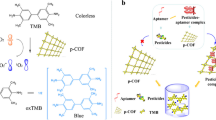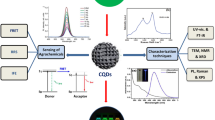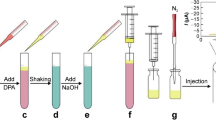Abstract
Developing simple, efficient, and inexpensive method for trace amount organophosphorus pesticides’ (OPs) detection with high sensitivity and specificity is of significant importance for guaranteeing food safety. Herein, an Ag/Au bimetallic nanoparticle-based acetylcholinesterase (AChE) surface-enhanced Raman scattering (SERS) biosensor was constructed for in situ simple and sensitive detection of pesticide residues in food. The principle of this biosensor exploited 4-mercaptophenylboronic acid (4-MPBA)-modified Ag/Au bimetallic nanoprobes as SERS signal probe to improve sensitivity and stability. The combination of AChE and choline oxidase (CHO) can hydrolyze acetylcholine (ATCh) to generate H2O2. The product of H2O2 selectively oxidizes the boronate ester of 4-MPBA, decreasing the Raman intensity of the B-O symmetric stretching. In the presence of OPs, it could inhibit the production of H2O2 by destroying the AChE activity, so the reduction of the SERS signal was also alleviated. Based on the principle, an Ag/Au bimetallic nanoparticle-based AChE SERS sensor was established without any complicated pretreatments. Benefiting from the synergistic effects of Ag/Au bimetallic hybrids, a linear detection range from 5×10−9 to 5×10−4 M was achieved with a limit of detection down to 1.7×10−9 M using parathion-methyl (PM) as the representative model of OPs. Moreover, the SERS biosensor uses readily available reagents and is simple to implement. Importantly, the proposed SERS biosensor was used to quantitatively analyze OP residues in apple peels. The levels of OPs detected in real samples by this method were consistent with those obtained using gas chromatography–mass spectrometry (GC–MS), suggesting the proposed assay has great potential applications for OPs in situ detection in food safety fields.
Graphical abstract







Similar content being viewed by others
References
Liu T, Xu SR, Lu SY, Qin P, Bi B, Ding HD, Liu Y, Guo XC, Liu XH. A review on removal of organophosphorus pesticides in constructed wetland: performance, mechanism and influencing factors. Sci Total Environ. 2019;651:2247–68.
Han W, Tian Y, Shen X. Human exposure to neonicotinoid insecticides and the evaluation of their potential toxicity: an overview. Chemosphere. 2018;192:59–65.
Guo YR, Liu R, Liu Y, Xiang DD, Liu YH, Gui WJ, Li MY, Zhu GN. A non-competitive surface plasmon resonance immunosensor for rapid detection of triazophos residue in environmental and agricultural samples. Sci Total Environ. 2018;613:783–91.
Cao J, Wang M, Yu H, She Y, Cao Z, Ye J, Abd El-Aty AM, Hacimuftuoglu A, Wang J, Lao S. An overview on the mechanisms and applications of enzyme inhibition-based methods for determination of organophosphate and carbamate pesticides. J Agric Food Chem. 2020;68:7298–315.
Jokanovic M. Neurotoxic effects of organophosphorus pesticides and possible association with neurodegenerative diseases in man: a review. Toxicology. 2018;410:125–31.
Zhou T, Xiao X, Li G. Microwave accelerated selective Soxhlet extraction for the determination of organophosphorus and carbamate pesticides in ginseng with gas chromatography/mass spectrometry. Anal Chem. 2012;84:5816–22.
Deme P, Azmeera T, Kanjilal S, Jonnalagadda P, Upadhyayula VS. LC-MS/MS determination of organophosphorus pesticide residues in coconut water. Food Anal Methods. 2013;6:1162–9.
Zhu F, Ruan W, He M, Zeng F, Luan T, Tong Y, Lu T, Ouyang G. Application of solid-phase microextraction for the determination of organophosphorus pesticides in textiles by gas chromatography with mass spectrometry. Anal Chim Acta. 2009;650:202–6.
Pang S, Yang T, He L. Review of surface enhanced Raman spectroscopic (SERS) detection of synthetic chemical pesticides. TrAC, Trends Anal Chem. 2016;85:73–82.
Cai Y, Zhu H, Zhou W, Qiu Z, Chen C, Qileng A, Li K, Liu Y. Capsulation of AuNCs with AIE effect into metal−organic framework for the marriage of a fluorescence and colorimetric biosensor to detect organophosphorus pesticides. Anal Chem. 2021;93:7275–82.
Shen Y, Yan F, Huang X, Zhang X, Zhang Y, Zhang C, Jin J, Li H, Yao S. A new water-soluble and colorimetric fluorescent probe for highly sensitive detection of organophosphorus pesticides. RSC Adv. 2016;6:88096–103.
Velusamy V, Palanisamy S, Chen SW, Balu S, Yang TCK, Banks CE. Novel electrochemical synthesis of cellulose microfiber entrapped reduced graphene oxide: a sensitive electrochemical assay for detection of fenitrothion organophosphorus pesticide. Talanta. 2019;192:471–7.
Lin B, Yan Y, Guo M, Cao Y, Yu Y, Zhang T, Huang Y, Wu D. Modification-free carbon dots as turn-on fluorescence probe for detection of organophosphorus pesticides. Food Chem. 2018;245:1176–82.
Li H, Lv W, Yang Q, Li Q, Li F. Inorganic Recognizer-Assisted Homogeneous electrochemiluminescence determination of organophosphorus pesticides via target-controlled emitter release. J Agric Food Chem. 2021;69:6087–95.
Fu G, Sun DW, Pu H, Wei Q. Fabrication of gold nanorods for SERS detection of thiabendazole in apple. Talanta. 2019;195:841–9.
Zhang Y, Wang Z, Wu L, Pei Y, Chen P, Cui Y. Rapid simultaneous detection of multi-pesticide residues on apple using SERS technique. Analyst. 2014;139:5148–54.
Xu ML, Gao Y, Han XX, Zhao B. Detection of pesticide residues in food using surface-enhanced Raman spectroscopy: a review. J Agric Food Chem. 2017;65:6719–26.
Zhang Z, Yu Q, Li H, Mustapha A, Lin M. Standing gold nanorod arrays as reproducible SERS substrates for measurement of pesticides in apple juice and vegetables. J Food Sci. 2015;80:450–8.
Qian K, Yang L, Li Z, Liu J. A new-type dynamic SERS method for ultrasensitive detection. J Raman Spectrosc. 2013;44:21–8.
Liu Z, Wang Y, Deng R, Yang L, Yu S, Xu S, Xu W. Fe3O4 @Graphene Oxide@Ag particles for surface magnet solid-phase extraction surface-enhanced Raman scattering (SMSPE-SERS): from sample pretreatment to detection all-in-one. ACS Appl Mater Interfaces. 2016;8:14160–8.
Yan J, Han XJ, He JJ, Kang LL, Zhang B, Du YC, Zhao HT, Dong CK, Wang H-L, Xu P. Highly sensitive surface-enhanced Raman spectroscopy (SERS) platforms based on silver nanostructures fabricated on polyaniline membrane surfaces. ACS Appl Mater Interfaces. 2012;4:2752–6.
Zhang X-Y, Hu A, Zhang T, Lei W, Xue X-J, Zhou Y, Duley WW. Self-assembly of large-scale and ultrathin silver nanoplate films with tunable plasmon resonance properties. ACS Nano. 2011;5:9082–92.
Liu Z, Cheng L, Zhang L, Jing C, Shi X, Yang Z, Long Y, Fang J. Large-area fabrication of highly reproducible surface enhanced Raman substrate via a facile double sided tape-assisted transfer approach using hollow Au−Ag alloy Nanourchins. Nanoscale. 2014;6:2567–72.
Liu BH, Han GM, Zhang ZP, Liu RY, Jiang CL, Wang SH, Han MY. Shell thickness-dependent Raman enhancement for rapid identification and detection of pesticide residues at fruit peels. Anal Chem. 2012;84:255–61.
Zheng X, Chen Y, Chen Y, Bi N, Qi H, Qin M, Song D, Zhang H, Tian Y. High performance Au/Ag core/shell bipyramids for determination of thiram based on surface-enhanced Raman scattering. J Raman Spectrosc. 2012;43:1374–80.
Fortuni B, Inose T, Uezono S, Toyouchi S, Umemoto K, Sekine S, Fujita Y, Ricci M, Lu G, Masuhara A, Hutchison JA, Latterini L, Uji-i H. Chem Commun. 2017;53:11298–301.
Gao CB, Hu YX, Wang MS, Chi MF, Yin YD. Fully alloyed Ag/Au nanospheres: combining the plasmonic property of Ag with the stability of Au. JAm Chem Soc. 2014;136:7474–9.
Zhang Z, Yu Q, Li H, Mustapha A, Lin M. Standing gold nanorod arrays as reproducible SERS substrates for measurement of pesticides in apple juice and vegetables. J Food Sci. 2015;80:450–8.
Alsammarraie FK, Lin M. Using standing gold nanorod arrays as surface-enhanced Raman spectroscopy (SERS) substrates for detection of carbaryl residues in fruit juice and milk. J Agric Food Chem. 2017;65:666–74.
Liu X, Osada M, Kitamura K, Nagata T, Si D. Ferroelectric-assisted gold nanoparticles array for centimeter-scale highly reproducible SERS substrates. Sci Rep. 2017;7:1–8.
Li S, Pang C, Ma X, Zhang Y, Xu Z, Li J, Zhang M, Wang M. Microfluidic paper-based chip for parathion-methyl detection based on a double catalytic amplification strategy. Microchim Acta. 2021;188:438–45.
Xia D, Jiang P, Cai Z, Zhou R, Tu B, Gao N, Chang G, He H, He Y. Ag nanocubes monolayer-modified PDMS as flexible SERS substrates for pesticides sensing. Microchim Acta. 2022;189:232–41.
Cui H, Li S, Deng S, Chen H, Wang C. Flexible, transparent, and free-standing silicon nanowire SERS platform for in situ food inspection. ACS Sens. 2017;2:386–93.
Liou P, Nayigiziki FX, Kong F, Mustapha A, Lin M. Cellulose nanofibers coated with silver nanoparticles as a SERS platform for detection of pesticides in apples. Carbohydr Polym. 2017;157:643–50.
Hua X, Liu X, Shi H, Wang Y, Kim HJ, Gee SJ, Wang M, Liu F, Hammock BD. Development of a heterologous enzymelinked immunosorbent assay for organophosphorus pesticides with phage-borne peptide. RSC Adv. 2014;4:42445–53.
Tvorynska S, Barek J, Josypčuk B. Acetylcholinesterase-choline oxidase-based mini-reactors coupled with silver solid amalgam electrode for amperometric detection of acetylcholine in flow injection analysis. J Electroanal Chem. 2022;860:113883–92.
Yi Y, Zhu G, Liu C, Huang Y, Zhang Y, Li H, Zhao J, Yao S. A label-free silicon quantum dots-based photoluminescence sensor for ultrasensitive detection of pesticides. Anal Chem. 2013;85:11464–70.
Yan X, Song Y, Zhu CZ, Li HX, Du D, Su XG, Lin YH. MnO2 nanosheet-carbon dots sensing platform for sensitive detection of organophosphorus pesticides. Anal Chem. 2018;90:2618–24.
Huang S, Yao J, Chu X, Liu Y, Xiao Q, Zhang Y. One-Step Facile synthesis of nitrogen-doped carbon dots: a ratiometric fluorescent probe for evaluation of acetylcholinesterase activity and detection of organophosphorus pesticides in tap water and food. J Agric Food Chem. 2019;67:11244–55.
Han Y, Ye Z, Wang F, Chen T, Wei L, Chen L, Xiao L. Single-particle enumeration-based ultrasensitive enzyme activity quantification with fluorescent polymer nanoparticles. Nanoscale. 2019;11:14793–801.
Zheng Q, Yu Y, Fan K, Ji F, Wu J, Ying Y. A nano-silver enzyme electrode for organophosphorus pesticide detection. Anal Bioanal Chem. 2016;408:5819–27.
Cheng W, Tang P, He X, Xing X, Xing M, Lu L, Ju P, Wang Y, Liu S, Lu X, Zhong L. Dynamic monitoring and quantitative characterization of intracellular H2O2 content by using SERS based boric acid nanoprobe. Talanta. 2020;214:120863–70.
Zhang X, Zhang G, Zhang B, Su Z. Synthesis of hollow Ag–Au bimetallic nanoparticles in polyelectrolyte multilayers. Langmuir. 2013;29:6722–7.
Cheng W, Tang P, He X, Xing X, Xing M, Lu L, Ju P, Wang Y, Liu S, Lu X, Zhong L. Dynamic monitoring and quantitative characterization of intracellular H2O2 content by using SERS based boric acid nanoprobe. Talanta. 2020;214:120863–70.
Li X, Duan X, Yang P, Li L, Tang B. Accurate in situ monitoring of mitochondrial H2O2 by robust SERS nanoprobes with a Au−Se interface. Anal Chem. 2021;93:4059–65.
Acknowledgements
We thank the Natural Science Foundation of China (21675072), the Natural Science Foundation of Shandong Province (ZR2019MB068, ZR2022MB012), the Project of Shandong Province Higher Educational Science and Technology Program (KJ2018BZC043), and the Young Innovative Talents Introduction and Cultivation Program for Colleges and Universities of Shandong Province: Innovative Research Team on biomedical sensing and food safety Research.
Author information
Authors and Affiliations
Corresponding authors
Ethics declarations
Conflict of interest
The authors declare no competing interests.
Additional information
Publisher’s note
Springer Nature remains neutral with regard to jurisdictional claims in published maps and institutional affiliations.
Supplementary information
ESM 1
(DOC 1.84 mb)
Rights and permissions
Springer Nature or its licensor (e.g. a society or other partner) holds exclusive rights to this article under a publishing agreement with the author(s) or other rightsholder(s); author self-archiving of the accepted manuscript version of this article is solely governed by the terms of such publishing agreement and applicable law.
About this article
Cite this article
Xu, S., Li, M., Li, X. et al. Engineering an Ag/Au bimetallic nanoparticle-based acetylcholinesterase SERS biosensor for in situ sensitive detection of organophosphorus pesticide residues in food. Anal Bioanal Chem 415, 203–210 (2023). https://doi.org/10.1007/s00216-022-04400-0
Received:
Revised:
Accepted:
Published:
Issue Date:
DOI: https://doi.org/10.1007/s00216-022-04400-0




